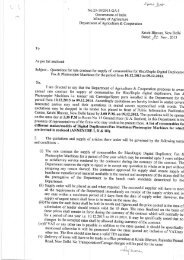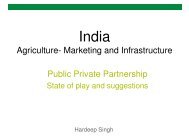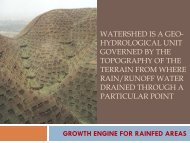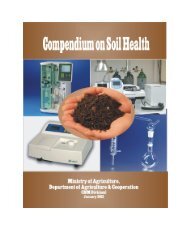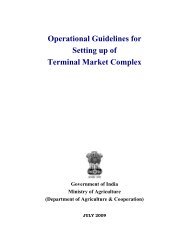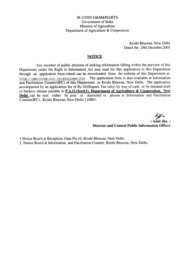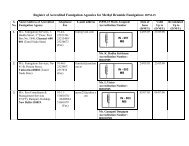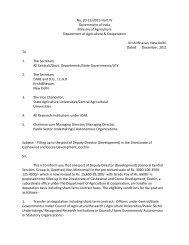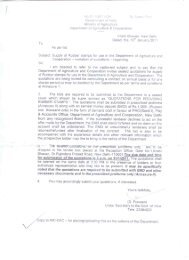Annual Report 2009-2010 - Department of Agriculture & Co-operation
Annual Report 2009-2010 - Department of Agriculture & Co-operation
Annual Report 2009-2010 - Department of Agriculture & Co-operation
You also want an ePaper? Increase the reach of your titles
YUMPU automatically turns print PDFs into web optimized ePapers that Google loves.
Integrated Scheme <strong>of</strong> Pulses, Oilpalm<br />
and Maize(ISOPOM), Macro<br />
Management <strong>of</strong> <strong>Agriculture</strong>(MMA) and<br />
NFSM for Rabi and Summer <strong>2009</strong>-10.<br />
Restriction on import <strong>of</strong> fodder (barseem<br />
seed) was relaxed. Distribution <strong>of</strong> seed<br />
minikits <strong>of</strong> oilseeds, pulses and maize<br />
was increased for Rabi <strong>2009</strong>. A special<br />
review <strong>of</strong> seed requirements for late<br />
Kharif and early Rabi <strong>2009</strong> and Kharif <strong>2010</strong><br />
was conducted, Zonal <strong>Co</strong>nferences and<br />
Rabi campaign programmes with the<br />
state governments were held to enable<br />
the formulation <strong>of</strong> appropriate action<br />
plans for the Rabi season <strong>2009</strong>-10.<br />
Funds were made available under<br />
Centrally Sponsored Programmes like<br />
RKVY, NFSM, NHM, MMA, etc., to enable<br />
taking up the agriculture re-construction<br />
programme.<br />
1.15 The recovery <strong>of</strong> monsoon in September<br />
<strong>2009</strong> is expected to protect the prospects <strong>of</strong> Rabi<br />
<strong>2009</strong>-10. However, overall agricultural growth<br />
rates during <strong>2009</strong>-10 have been severely<br />
impacted.<br />
Flagship Programmes <strong>of</strong> the <strong>Department</strong><br />
<strong>of</strong> <strong>Agriculture</strong> and <strong>Co</strong><strong>operation</strong><br />
1.16 The <strong>Department</strong> <strong>of</strong> <strong>Agriculture</strong> and<br />
<strong>Co</strong><strong>operation</strong> has implemented a number <strong>of</strong><br />
flagship programmes:<br />
National Food Security Mission (NFSM):<br />
1.17 The NFSM has helped to widen the food<br />
basket <strong>of</strong> the country with significant<br />
contributions coming from the NFSM districts.<br />
Productivity gains <strong>of</strong> 25% and more have been<br />
recorded in many districts.<br />
1.18 Significant outputs have been recorded<br />
under NFSM since inception <strong>of</strong> the scheme in<br />
2007-08. New farm practices have been<br />
encouraged through nearly 2.87 lakh<br />
demonstrations <strong>of</strong> improved varieties <strong>of</strong> rice and<br />
wheat. System <strong>of</strong> Rice Intensification (SRI) for<br />
rice as well as hybrid rice has been promoted.<br />
Nearly 84.03 lakh quintals <strong>of</strong> high yielding<br />
varieties <strong>of</strong> rice, wheat and pulses and hybrid<br />
seed <strong>of</strong> rice have been distributed. 56.14 lakh<br />
hectare <strong>of</strong> area has been treated with soil<br />
ameliorants (gypsum/lime/micro nutrients) to<br />
restore soil fertility. 21.90 lakh hectare <strong>of</strong> farm<br />
land has been treated under Integrated Pest<br />
Management (IPM). 10.42 lakh improved farm<br />
machinery/water saving devices have been<br />
distributed. Capacity building <strong>of</strong> farmers has<br />
been encouraged through arranging 27,834<br />
farmers' field schools at the farm level. So far,<br />
the targeted efforts <strong>of</strong> the last 3 years <strong>of</strong> mission<br />
implementation have resulted in increased<br />
production <strong>of</strong> rice and wheat. However, pulses<br />
production has remained more or less the same.<br />
Rashtriya Krishi Vikas Yojana<br />
1.19 Rastriya Krishi Vikas Yojana (RKVY), the<br />
biggest scheme in the agriculture sector<br />
presently, aims at incentivising states to increase<br />
outlays for agriculture and allied sectors so as to<br />
significantly contribute to the target <strong>of</strong> 4 percent<br />
growth in the Eleventh Plan. An outlay <strong>of</strong> Rs.<br />
25,000 crore for the Eleventh Five Year Plan has<br />
been earmarked for RKVY. It is an entirely grant<br />
based programme.<br />
1.20 RKVY provides considerable flexibility to<br />
state governments, and incentivises them to<br />
spend more on agriculture on the basis <strong>of</strong> district<br />
and state agriculture plans prepared with the<br />
participation <strong>of</strong> the local people. State and district<br />
plans under RKVY are to be prepared based on<br />
the resources available under all state and central<br />
schemes. RKVY funds provide substantial scaling<br />
up for specific programmes in the agricultural<br />
sector. The scheme is also being used to fill gaps<br />
Overview<br />
5



